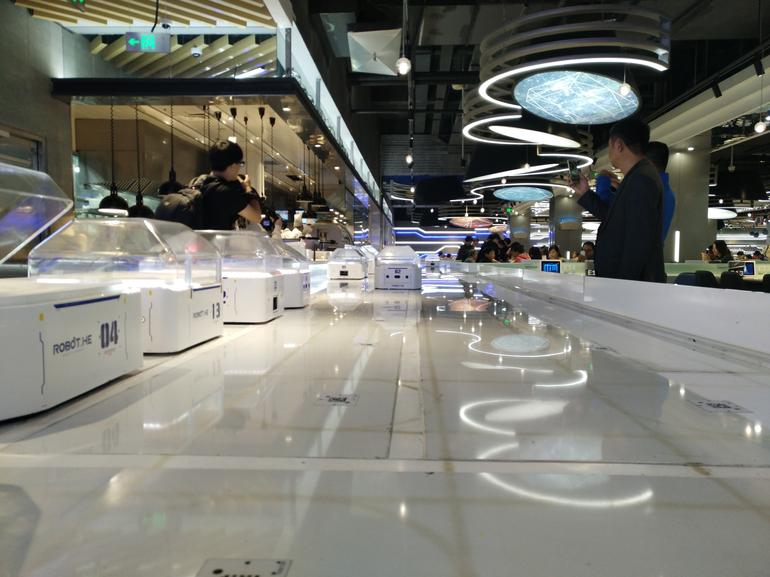Hema’s Robot.He in-store dining experience
Image: Asha McLean/ZDNet
Chinese ecommerce giant Alibaba has gone all in on its New Retail play, taking the online shopping experience to bricks-and-mortar stores, starting with its own backyard.
According to Hema CEO Hou Yi, technology has brought a lot of transformation into the retail experience, and there is no reason why a customer can’t have the same experience in-store as they do online.
Alibaba opened its first Hema — Hippo Fresh — store in January 2016 and as of next month, there will be over 100 peppered across China.
Products can be bought both online and offline from Hema, with Hou touting the idea as allowing customers to order food for the night on their commute home. Delivery is guaranteed for 30 minutes after an order has been placed if the customer lives within a 3km radius of a Hema store.
Alibaba said house prices have soared in the delivery radius where Hema has a store presence.
Hema has gained popularity in China for its mobile-first approach to grocery shopping.
In the bricks-and-mortar shop, customers use a mobile app to scan items as they shop to get product information. All information, such as pricing, is updated live to the online store, which customers can also use to shop.
Each store serves as its own 24-hour fulfillment centre, backed by Alibaba’s warehouse tech.
Alibaba’s Alipay is also used for checkout both online and offline, with the company saying its artificial intelligence technology uses information about previous purchases to serve up personalised recommendations for shoppers.
“We must blaze the trail and be the pioneer of New Retail so our partners, such as the farmers, brands, real estate firms, restaurant operators, and even our cohorts can learn from our experiences,” Hou said.
Must read: The technology enabling Alibaba to sell $30.8 billion in Double 11 goods
Nestled inside one of Alibaba’s Hema stores in Shanghai is the company’s robot dining experience, Robot.He.
When a customer arrives they check-in to a kiosk to book a table. The customer scans the QR code on their app to organise a seat.
The customer then chooses the food they want to eat from the Hema supermarket, which, after purchase, is sent to the kitchen for cooking using ceiling-mounted conveyor belts.
The belt takes the bag to a robotic arm that transfers it to a refrigerator until the food is ready to be prepared.
While seated, the customer can order additional food through the app.
Once the food is cooked, robots deliver the food to the diner’s table.
Disclosure: Asha McLean travelled to 11.11 in Shanghai as a guest of Alibaba
SEE ALSO
Starbucks leveraging Alibaba to convert China into a country of coffee lovers
In partnership with Alibaba, Starbucks is using its largest store to trial new concepts, including using technologies such as augmented reality.
JD.com expands into fresh food supermarkets in Beijing
JD.com, one of the two major ecommerce platforms in China, followed the steps of its rival Alibaba and launched its first offline high-tech supermarket in Beijing last week.
As Alibaba ramps up, Amazon loses the plot in Asia
The US online retailer finally introduces Amazon Prime in Singapore but the launch has been described as “piecemeal”, which should give Alibaba even more room to expand its own footprint in the region.
Robot restaurants and sci-fi kitchens: How tech is changing the way we eat (TechRepublic)
Robot recipes, 3D printed meals, pocket scanners, touch-screen waiters — new futuristic technologies are beginning to transform the way we prepare, distribute, and eat our food.

